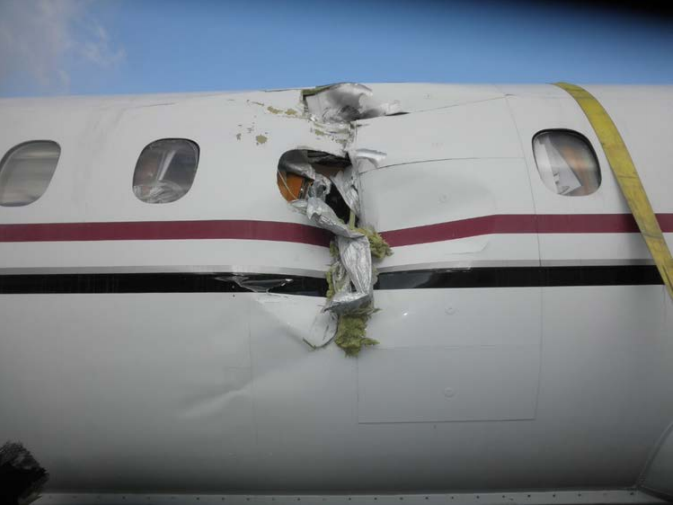
The PenAir flight that crashed at the Dutch Harbor airport last month, killing a passenger, landed amid unfavorable, shifting winds, according to an initial federal report released Friday. It was also captained by a pilot with relatively little experience at the controls of the Saab 2000 plane he was flying, the report said.
The captain told National Transportation Safety Board investigators that he had spent about 14,000 hours flying in Dash 8s, another smaller, slower plane that’s also used by RavnAir Group, PenAir’s parent company. But he had just 101 hours in a Saab 2000, he said.
The first officer’s type of experience was similar: 1,450 total flight hours, of which 147 were in a Saab 2000.
The flight, from Anchorage to the tricky Dutch Harbor airport, had 42 people on board when it flew off the end of the runway. Passengers said it felt like the plane didn’t have brakes.
The flight crew said the plane touched down about 1,000 feet down the runway, then started reverse thrust and “normal wheel-braking” before using “maximum braking,” the report said.
The flight crew told investigators that they steered the plane to the right as it approached the end of the runway to avoid going into the water, and the Saab 2000 came to rest tilting downward on a rocky embankment on shore.
A 5-foot-long propeller blade was found inside the plane’s cabin, and another was “loosely stuck” in the structure outside the fuselage, the report said.
A 38-year-old Washington man, David Oltman, was killed in the accident, and about 10 more were injured. It was the first fatal passenger accident this year among all U.S. airlines, which are more stringently regulated than the flight services that operate in Alaska’s smaller rural communities.
Friday’s NTSB update is a detailed, seven-page statement of facts about the flight and the investigation, with sections on the runway, the flight recorders, the plane and its engines. It does not assign a cause to the crash; that could come a year or more from now, in a more in-depth report.
After last month’s crash, Alaska pilots and the family that owned PenAir before it was bought out of bankruptcy last year both questioned the pilot’s decision to land with what weather data suggested was a strong tailwind, contradicting standard guidance for pilots. Friday’s report adds new weight to those questions.
As the plane flew its second approach to the runway after an aborted landing, a local weather observer reported winds out of the northwest at 28 mph. The Saab 2000 landed flying roughly the same direction, on what’s known as the runway’s “13” orientation, rather than the other direction, known as runway “31.”
“Transmissions between the weather observer and another airplane indicated that winds favored runway 31 but could shift back to runway 13,” the report said.
Dutch Harbor’s runway, with a mountain on one side and water at both ends, is shorter than normal and notoriously difficult to land on. PenAir’s previous owners say they had guidelines that required pilots to have at least 300 hours of experience in the Saab 2000 plane the airline uses before they could captain a flight to the airport, though management could waive that standard.
PenAir has stopped flying the Saab 2000s into Dutch Harbor, and regularly scheduled air service with a Dash 8 resumed Thursday, nearly a month after the crash. The Dash 8s are widely used by RavnAir Group, PenAir’s parent company, which also flies from Anchorage to Fairbanks and rural Western Alaska.
While scheduled service was canceled for the past month, RavnAir and other companies had been flying charter service in and out of the community, with the city of Unalaska helping to coordinate flights. But residents and people who work in Dutch Harbor’s major commercial fishing industry have complained of steep prices, logistical problems and delays.
City officials are now asking whether they can take legal action against the airlines that were involved in last month’s flight that crashed — which includes not just PenAir but Alaska Airlines.
Alaska Airlines, through a longstanding relationship that predated PenAir’s bankruptcy, marketed PenAir’s flights to Dutch Harbor and sold tickets, allowing Alaska Airlines passengers to accumulate frequent flier miles and enjoy the flexibility of the company’s loyalty program.
A week after the crash, Alaska Airlines said it would not resume marketing scheduled service into Dutch Harbor in Saab 2000s until reviewing preliminary findings from the NTSB and the plane’s manufacturer. On Friday, the company said flights to and from Dutch Harbor that it had marketed were canceled through May 31, 2020. Passengers who booked PenAir flights through Alaska Airlines are being rebooked on Ravn flights at no charge, the company said.
“Currently, there are no plans for Alaska Airlines to market service to and from Dutch Harbor on Ravn or any other carrier,” it said in a blog post.
